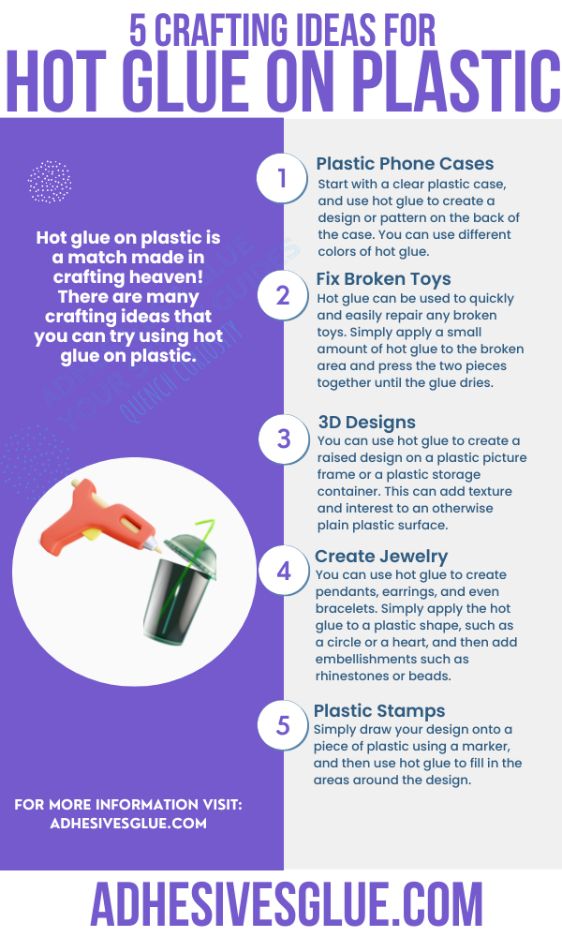Hot glue is a versatile crafting tool that can be used for a variety of projects. It’s great for creating quick and easy bonds but is not always the best option for every material.
But can we use hot glue on plastic? Hot glue is made of thermoplastic, which makes it a perfect choice. However, there are some plastics hot glue will not work on.
In this blog post, we’ll explore why hot glue on plastic is a match made in crafting heaven, and what plastics hot glue will not work on.
Contents
Why Hot Glue Works on Plastic?
Hot glue is made from a thermoplastic adhesive that melts when heated and solidifies as it cools. This means that it can bond to a variety of surfaces, including plastic, as long as the plastic is not heat-sensitive.
One of the reasons that hot glue works so well on plastic is that it creates a strong, durable bond. It’s also easy to use and can be applied quickly, making it perfect for crafting projects that require a fast bond.
4 Plastics Hot Glue Will Not Work On:
While hot glue is a go-to adhesive for many crafting projects, it’s important to understand its limitations when it comes to bonding certain types of plastics. Some plastics have low surface energy, meaning they are not as receptive to adhesives.

1. Polyethylene:
Polyethylene is a common type of plastic found in packaging materials, such as plastic bags and milk jugs. It is notoriously difficult to bond because of its low surface energy, its melting point being less than 110°C, and hot glue melting at 120 °C.
and hot glue may not be able to create a strong enough bond to keep the plastic together.
2. Polypropylene:
Polypropylene is another low surface energy plastic found in items such as food containers and drink cups, and hot glue may not be able to create a strong enough bond to hold these materials together.
3. Silicon:
Silicone has a high melting point, and it may not be able to withstand the high temperatures required for hot glue to melt and create a bond. It is also a non-stick material, which means that it is resistant to adhesion.
4. Polytetrafluoroethylene:
Fluoropolymers, such as PTFE (polytetrafluoroethylene), are known for their low surface energy and non-stick properties, making them difficult to bond with adhesives. Hot glue is no exception to this rule, as it may not create a strong enough bond with fluoropolymers.
Understanding the limitations of hot glue on certain types of plastics can help you choose the right adhesive for your crafting project. By selecting the appropriate adhesive, you can ensure that your project is strong, durable, and able to stand the test of time.
5 Benefits of Using Hot Glue on Plastic:
There are several benefits to using hot glue on plastic for crafting projects.
1. Durable:
One of the main benefits is that it creates a bond that is strong and durable. This means the finished product will hold up well over time, even with regular use.
2. Quick Bonding:
Another benefit of using hot glue on plastic is that it’s a quick and easy bonding method. Unlike some other adhesives, hot glue dries quickly, which means that you can move on to the next step of your project without waiting for it to dry.
3. Easy Application:
Hot glue is also easy to apply, even for beginners. All you need is a hot glue gun and some glue sticks, and you’re ready to go. The glue gun heats up quickly, and the glue sticks melt easily, so you can apply the glue exactly where you need it.
4. Cost-Effective:
Using hot glue on plastic is also a cost-effective option for crafting projects. Hot glue guns and glue sticks are relatively inexpensive, especially compared to other types of adhesives. This makes it a great choice for crafters on a budget.
5. Variety:
Another advantage of hot glue is that it can be used on a wide variety of plastic types, including smooth, textured, and even some porous plastics. This versatility means that it can be used for a variety of crafting projects, from repairing broken plastic items to creating new ones.
4 Tips for Using Hot Glue on Plastic:
While hot glue is a great choice for bonding plastic, there are a few tips to keep in mind to ensure that your project turns out well.
1. Type of Plastic:
Hot glue works best on smooth, non-porous plastics. If you’re working with a textured or porous plastic, you may need to use a different type of adhesive.
2. Temperature:
Some plastics may melt if they get too hot, so it’s important to start with a low temperature and gradually increase it until you find the right temperature for your plastic.
3. Apply in Layers:
This will help ensure the glue dries evenly and creates a strong bond. If you apply too much glue at once, it may not dry properly and could create a weak bond.
4. Test the Bond:
Try pulling on the two pieces of plastic to ensure that they are securely bonded before using the item. This will help to prevent any accidents or damage to your project.
5 Crafting Ideas for Hot Glue on Plastic:
Now that you know why hot glue on plastic is a match made in crafting heaven, it’s time to get creative!

There are many crafting ideas that you can try using hot glue on plastic.
1. Plastic Phone Cases:
Start with a clear plastic case, and use hot glue to create a design or pattern on the back of the case. You can use different colors of hot glue to create a unique and personalized design. Once the glue has dried, you’ll have a one-of-a-kind phone case that reflects your style.
2. Fix Broken Toys:
Whether it’s a toy that’s been broken by a child or a kitchen utensil that’s seen better days, hot glue can be used to quickly and easily repair it. Simply apply a small amount of hot glue to the broken area and press the two pieces together until the glue dries.
3. 3D Designs:
Hot glue can also be used to create 3D designs on plastic surfaces. For example, you can use hot glue to create a raised design on a plastic picture frame or a plastic storage container. This can add texture and interest to an otherwise plain plastic surface.
4. Create Jewelry:
If you’re looking for a fun and easy craft project, try using hot glue to create jewelry out of plastic. You can use hot glue to create pendants, earrings, and even bracelets. Simply apply the hot glue to a plastic shape, such as a circle or a heart, and then add embellishments such as rhinestones or beads.
5. Plastic Stamps:
Simply draw your design onto a piece of plastic using a marker, and then use hot glue to fill in the areas around the design. Once the glue has dried, you’ll have a stamp that you can use for scrapbooking or other paper crafts.
Conclusion:
In conclusion, hot glue on plastic is a match made in crafting heaven. Hot glue creates a strong, durable bond on plastic surfaces, and it’s easy to use and cost-effective. With a little creativity, you can use hot glue on plastic to create a wide variety of crafting projects, from repairing broken items to creating new ones.
Keep in mind the tips for using hot glue on plastic to ensure that your project turns out well. So, the next time you’re looking for a versatile adhesive for your crafting project, consider hot glue on plastic.

I fell in love with crafts & fixing things when I was 11 years old – after discovering the world of blogging, I am combining my passions to present the world with well-researched guides & reviews about everything related to adhesives & glue.